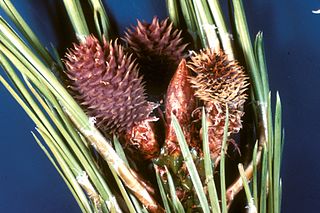
Dioryctria sylvestrella, the new pine knot-horn or maritime pine borer, is a moth of the family Pyralidae. It is found in Europe, parts of Asia and North Africa. The adult is a small mottled brown and white insect with a wingspan of 28 to 35 mm. The moth flies in a single generation from June to October and is a pest of maritime pine and several other species of pine, on which the caterpillars feed.

Dioryctria auranticella, the ponderosa pineconeworm moth, is a moth of the family Pyralidae. The species was first described by Augustus Radcliffe Grote in 1883. It is found in western North America from southern British Columbia south to California and Arizona, east to South Dakota and New Mexico.

Dioryctria ponderosae, the ponderosa twig moth, is a moth of the family Pyralidae. The species was first described by Harrison Gray Dyar Jr. in 1914. It is found in North America from Washington and Montana south to California and northern Mexico.
Dioryctria cambiicola, the western pine moth, is a species of snout moth in the genus Dioryctria. It was described by Harrison Gray Dyar Jr. in 1914 and is found in North America from British Columbia and Alberta south to California and New Mexico.
Dioryctria cibriani is a species of snout moth in the genus Dioryctria. It was described by Akira Mutuura and Herbert H. Neunzig in 1986 and is known from Mexico.
Dioryctria erythropasa is a species of snout moth in the genus Dioryctria. It was described by Harrison Gray Dyar Jr. in 1914 and is found from Arizona south along the Mexican Pacific coast to Central America.
Dioryctria raoi is a species of snout moth in the genus Dioryctria. It was described by Akira Mutuura in 1971 and is known from northern India.
Dioryctria majorella is a species of snout moth in the genus Dioryctria. It was described by Harrison Gray Dyar Jr. in 1919 and is known from Mexico.
Dioryctria pinicolella is a species of snout moth in the genus Dioryctria. It was described by Hans Georg Amsel in 1962 and is known from Central America, including Mexico and Guatemala.
Dioryctria rossi is a species of snout moth in the genus Dioryctria. This moth was discovered and named by Dr. Douglas Alexander Ross, chief entomologist at the Vernon forest entomology laboratory and research centre in Vernon, British Columbia, from 1950 to 1970. It was described by Eugene G. Munroe in 1959. It is found in western North America, from southern British Columbia to northern Mexico and east to New Mexico.
Dioryctria martini is a species of snout moth in the genus Dioryctria. It was described by Akira Mutuura and Herbert H. Neunzig in 1986. It is found in the Mexican state of Durango and city of Toluca.
Dioryctria fordi is a species of snout moth in the genus Dioryctria. It was described by Julian P. Donahue and Herbert H. Neunzig in 2002 and is known from the US state of California.
Dioryctria monticolella is a species of snout moth in the genus Dioryctria. It was described by Akira Mutuura, Eugene G. Munroe and Douglas Alexander Ross in 1969, and it is known from southern British Columbia, Canada.

Dioryctria okanaganella is a species of snout moth in the genus Dioryctria. It was described by Akira Mutuura, Eugene G. Munroe and Douglas Alexander Ross in 1969. It is found in western North America from southern British Columbia to northern California.
Dioryctria pryeri, the splendid knot-horn moth, is a species of snout moth in the genus Dioryctria. It was described by Ragonot in 1893, and is known from Japan, Taiwan and China.
Dioryctria rubella, the pine shoot moth, is a species of snout moth in the genus Dioryctria. It was described by George Hampson in 1891 and is known from south-east Asia, including China and the Philippines.
Dioryctria tumicolella is a species of snout moth in the genus Dioryctria. It was described by Akira Mutuura, Eugene G. Munroe and Douglas Alexander Ross in 1969, and is known from British Columbia, Canada, but is possibly present in all of north-western North America.
Dioryctria vancouverella is a species of snout moth in the genus Dioryctria. It was described by Akira Mutuura, Eugene G. Munroe and Douglas Alexander Ross in 1969, and is known from southern British Columbia, Canada. It is named for the city of Vancouver, from which the type specimen was collected.
Dioryctria yatesi, the mountain pine coneworm, is a species of snout moth in the genus Dioryctria. It was described by Akira Mutuura and Eugene G. Munroe in 1979 and is limited to the mountains of the coastal south-eastern United States and Tennessee.
Dioryctria yuennanella is a species of snout moth in the genus Dioryctria. It was described by Aristide Caradja in 1937 and is known from Yunnan, China.



